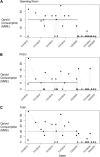Decreased Opioid Consumption in Bone Marrow Harvest Patients Using Quadratus Lumborum Blocks in a Standardized Protocol
- PMID: 35559351
- PMCID: PMC9086676
- DOI: 10.3389/fmed.2022.862309
Decreased Opioid Consumption in Bone Marrow Harvest Patients Using Quadratus Lumborum Blocks in a Standardized Protocol
Abstract
Purpose: Bone marrow harvesting is associated with significant postoperative pain that may have potential negative consequences for the patient and health care system. In the current absence of uniform guidelines, there exists considerable variability amongst providers with respect to perioperative analgesia, especially opioid administration. In this initiative, we explored the potential for preoperative bilateral quadratus lumborum blocks in combination with a standardized perioperative analgesic protocol to manage pain with the goal of reducing perioperative narcotic usage and thereby improving opioid stewardship.
Methods: Adults who underwent bone marrow donation from 2018 to 2020 were included in this analysis (n = 32). The pre-implementation group (n = 19) was reviewed retrospectively while the implementation group (n = 13) was evaluated prospectively. Patient demographics, pain scores, and opioid consumption were evaluated.
Results: Patient characteristics were equivalent except for anesthesia type with an increased number of patients in the implementation group undergoing spinal anesthesia. The implementation group showed significantly reduced median intraoperative (20.0 mg vs. 0.0 mg; p < 0.001) and total opioid consumption (20.5 mg vs. 0.0 mg; p < 0.001). The number of patients who received any opioids decreased from 84.2% (16/19) before implementation to 23.1% (3/13) after implementation.
Conclusion: This change in practice suggests that implementation of a standardized perioperative protocol, including bilateral quadratus lumborum blocks, for bone marrow harvest patients leads to reduced perioperative opioid administration without compromising immediate perioperative pain control.
Keywords: bone marrow harvest; local anesthesia; nerve block; opioid analgesics; postoperative pain; quadratus lumborum; regional anesthesia.
Copyright © 2022 McCoy, Hay, Romeo, Doty, Wolf and Hudspeth.
Conflict of interest statement
The authors declare that the research was conducted in the absence of any commercial or financial relationships that could be construed as a potential conflict of interest.
Figures


References
-
- Flowers ME, Parker PM, Johnston LJ, Matos AV, Storer B, Bensinger WI, et al. Comparison of chronic graft-versus-host disease after transplantation of peripheral blood stem cells versus bone marrow in allogeneic recipients: long-term follow-up of a randomized trial. Blood. (2002) 100:415–9. 10.1182/blood-2002-01-0011 - DOI - PubMed
-
- Lee SJ, Logan B, Westervelt P, Cutler C, Woolfrey A, Khan SP, et al. Comparison of patient-reported outcomes in 5-year survivors who received bone marrow vs peripheral blood unrelated donor transplantation: long-term follow-up of a randomized clinical trial. JAMA Oncol. (2016) 2:1583–9. 10.1001/jamaoncol.2016.2520 - DOI - PMC - PubMed
LinkOut - more resources
Full Text Sources

